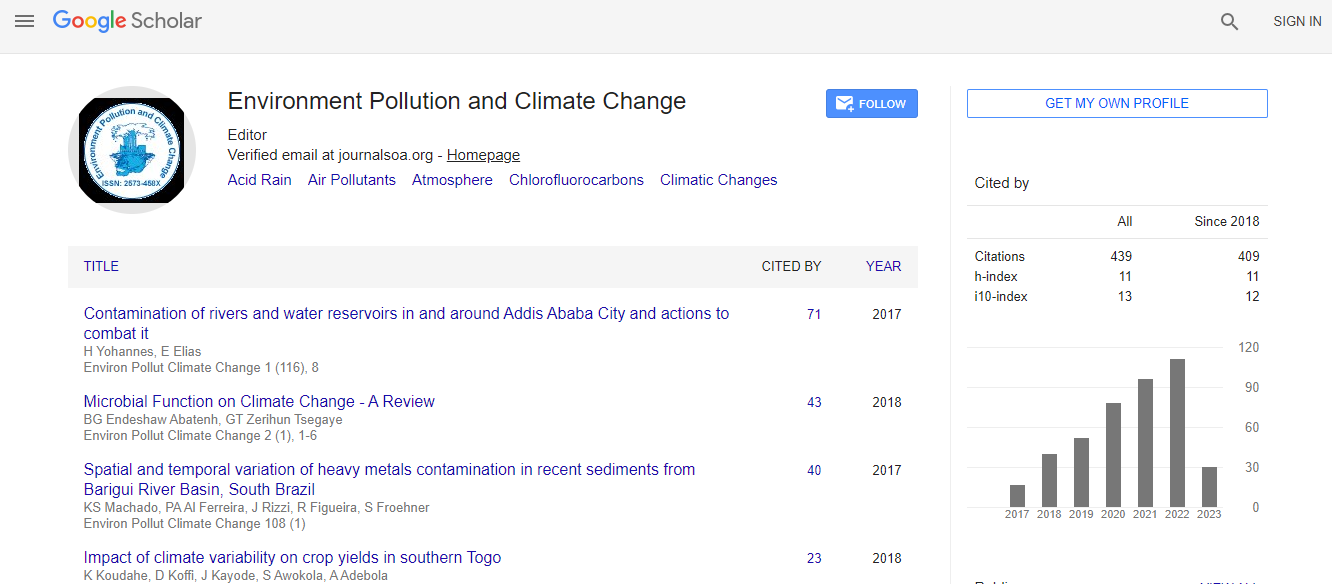Enviro-Technological Perspectives on Climate Change Mitigation in Urban and Rural Environments
*Corresponding Author: Dr. Vijayan Gurumurthy Iyer, Faculty Consultant (Environmental Climate Change and Control), Techno-Economic-Environmental Study and Check Consultancy Services, Patna, Bihar, India, Email: vijayaniyergurumurthy@rediffmail.comReceived Date: Sep 01, 2023 / Published Date: Sep 28, 2023
Citation: Iyer VG (2023) Enviro-Technological Perspectives on Climate Change Mitigation in Urban and Rural Environments. Environ Pollut Climate Change 7: 351.DOI: 10.4172/2573-458X.1000351
Copyright: © 2023 Iyer VG. This is an open-access article distributed under the terms of the Creative Commons Attribution License, which permits unrestricted use, distribution, and reproduction in any medium, provided the original author and source are credited.
Abstract
In this article enviro-technological perspectives on climate change mitigation in urban and rural environments are discussed. The entrepreneurship development through green economical model for sustainable entrepreneurship is designed and developed for an efficient and effective solid and hazardous waste management prior to environmental impact assessment (EIA) process. The Resource Conservation and Reecovery (RCRs) and EIAs are designed and developed to protect the environment during the post COVID-19 World. Strategic environmental assessment (SEA) process can be broadly defined as a study of the impacts of a proposed project, plan, project, policy or legislative action on the environment and sustainability. The root cause problem solution for ozone layer depletion potential (OLP) impact, global warming potential (GWP) impact and green house synergic (augmentative) gas (GHG) emissional impacts of 57 Giga tons of Carbon dioxide equivaenent in context to generic, source specific and industrial specific plants are measured, monitored and mitigated by international environmental impact assessment process for the sustainable environmental climate change and control. In this research, SEA process has been aimed in order to incorporate environmental and sustainability factors in to project planning and decision making (PPDM ) process such as project formulation and appraisal of Indo-Matsushita midget electrode (battery carbon rod) plant in 1979 at Tada that included policies, programs, plans and legislative actions. Sustainable entrepresurship development is a kind of development that meets the needs of the present without compromising the ability and efficacy of future generations to meet their own needs. Environmental Impact Assessment (EIA) process can be defined as the systematic study and check of the potential impacts (effects) of proposed projects, plans, programs, policies or legislative actions relative to the physicalchemical, biological, bio-physical, radio-active and cultural, and socioeconomic components of the total environment. The primary purpose of the EIA process is to encourage the consideration of the environment in organizational project planning and decision-making process and to arrive at actions that are environmentally compatible. PCPPDM process should include the integrated consideration of technical or engineering, economic, environmental, safety, and health, social and sustainability factors to achieve business excellence. The objective of the study is to conceptualize and develop SEA process for the climate change and environmental pollution control and a course module is developed entitled “BIPARD training and research course module” on pollution, climate change, afforestation and global warming control. The design of the study is cross sectional. Environmental Health Impact Assessment (EHIA) process has been conducted for petroleum and petrochemical, mining and nuclear power plant to consider the environmental quality, safety and health impacts to mitigate psychological health effects on workers and nearby residents. Social Impact Assessment (SIA) process can be defined as the systematic identification and evaluation of the potential social impacts (effects) of proposed projects, plans, programs, or legislative actions such that social consideration is encouraged in process and to arrive at actions that are socially compatible with reference to a sustainable sanitation project. SEA process concerns to environment and sustainability effects in process and arrive at proposed projects, plans, programs, and legislative actions that are compatible with respect to environment and sustainability issues. International EIA process required multi-disciplinary approach that has been conducted very early stage of Japanese Matsushita carbon rod project in 1982 for strategic environmental assessment. The paper highlights SEA process conducted for certain projects that based on operation and process approach and associated studies for sustainable development. Engineering hybrid lifecycle analysis (LCA) has been conducted for identifying and measuring the impact of petrochemical and corroded engineering structural products on the environment and sustain efficacy by means of mass and energy balance methods in M/S Madras Fertilizers Limited, Manali, Chennai, India. LCA considers the activities related to raw materials, transformation, ancillary materials, equipment, method, market, man power, production, use, disposal and ancillary equipment. As far as generic, spurce specific and industrial safety is concerned personal protective equipments and materials (PPEMs) that include garments, clothing, gloves, safety shoes, hard hats, safety glasses, shields, respirators, full aprons, safety belts, and other safety items which have to be used by an individual. Such equipment is important for personal protection and for safety. It is the manager’s and supervisor’s responsibility to ensure that they are used. The enactment of worker’s compensation law and occupational disease law shall increase materially the cost of insurance to industry. The increased cost and the certainty with which it is applied will put a premium on accident-prevention work. This cost can be materially reduced by the installation of safety devices. RCR research experience has shown that approximately 80% of all the generic, source specific and industrial accidents are preventable. EIA and EHIA processes have been conducted for a nuclear power plant to consider the safety and health impacts to mitigate psychological health loadings on workers and nearby residents. SEA system is a potentially useful element of good environmental management and sustainable development; however, as currently practiced in generic, source specific and industries, it is far from perfection. Emphasis should be given in generic, source specific and industries on maintaining economic viability of the operation, while in turn taking care to preserve the ecological and social sustainabilities of the country. International EIA process required multi-disciplinary approach that has been conducted very early stage of Indo-Matsushita Midget electrode project 1982 at Tada for technical, economic, ecological and social sustainablities.

